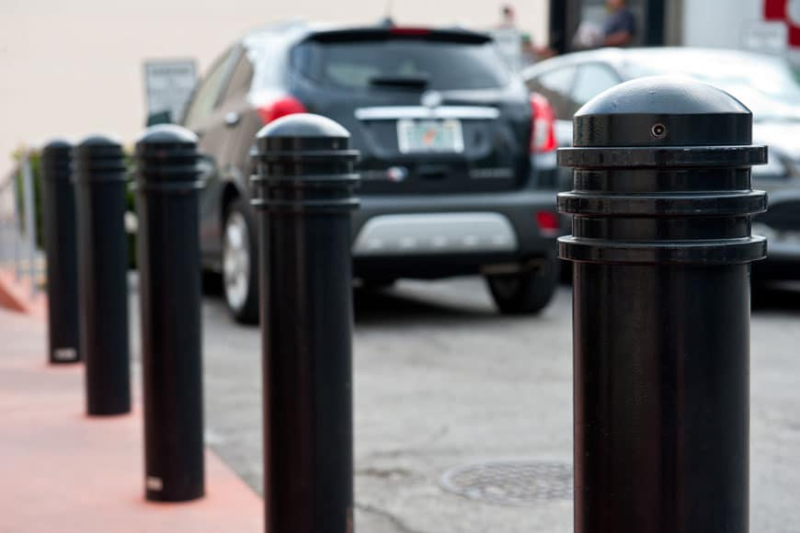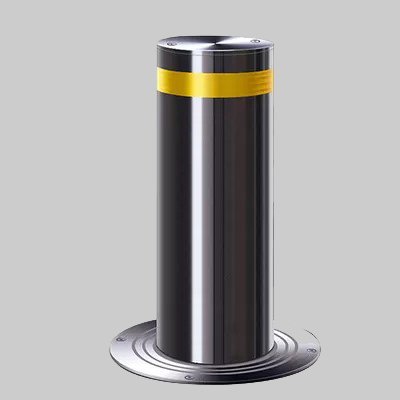A reserved parking spot or controlled lot entrance might seem secure on paper, but without a strong physical presence, it often invites the opposite. Bollards fill that gap between intent and enforcement. They are short, sturdy posts that stand guard in parking areas.
For property owners and site managers, parking bollards might be the solution to all your traffic control headaches. Want a deeper understanding? In this article, we define parking bollards and uncover everything you need to know.
What Are Parking Bollards?

Bollards are vertical posts property owners install to stop vehicles from moving into places where there shouldn’t. Granted, some spaces install them merely for their decorative appeal, but their core function still remains security, preventing cars from accessing certain areas. Bollards perform two main duties: managing traffic flow and safeguarding both human lives and physical assets.
Not all bollards are built the same, though. How strong and durable they are usually depends mostly on what materials were used, their design, and how solidly they are installed. Some bollards are fixed in place permanently; ohers can be removed or retracted when access is needed. So, which would you go for? Think about what purposes you will like your parking bollards to accomplish, then select the material type appropriately.
Materials Comparison
Steel and Iron Parking Bollards
Steel parking bollards have the highest strength level among all available types. They are used in high-impact areas like storefronts and pedestrian walkways. Most property owners find that steel parking lot bollards are valuable where cars tend to cut too close. Ductile iron versions are less common but equally sturdy. These materials are ideal when parking bollards need to resist collision.
In high-traffic car park bollard installations, steel can take repeated hits without folding, especially when filled with concrete for extra density.
Concrete Parking Bollards
Concrete bollards (cast in place or pre-molded) are heavy and immovable. They’re well-suited for static protection, like around fire lanes or ATMs. However, they lack flexibility. Once installed, they don’t move; they don’t retract, and repairs often require full replacement. Their weight also makes installation more demanding unlike lighter alternatives.
Cracking and weather wear over time are common downsides, particularly in freeze-thaw climates.
Plastic and Composite Parking Bollards
Plastic parking bollards are the lightweight version, and they come in colors. This means they offer more visual guidance, but they lack the full impact resistance. They’re often used where visibility matters more than security, such as lining lanes in large car park security bollard setups or separating bike lanes from vehicular traffic.
Some newer composites mimic the look of metal but come with flex bases or memory foam cores that allow them to bend and return. These are often found in eco-friendly projects or where temporary use is required.
Impact Ratings Explained
Not all bollards will stop a vehicle going 40 mph. That’s where impact ratings come in. Certified crash-rated bollards meet federal or international standards for stopping power, and they’re categorized by the speed and weight of the vehicle they can stop.
Impact ratings measure two key factors:
- The weight of the vehicle a bollard can stop
- The speed at which the vehicle is traveling
American K-Rating System:
| Rating | Stops a 15,000-pound vehicle traveling at: |
| K4 | 30 mph |
| K8 | 40 mph |
| K12 | 50 mph |
European PAS 68 System: This more detailed system specifies the exact vehicle weight, impact speed, and how far the vehicle will penetrate beyond the bollard after impact. The M30 rating (comparable to K4) provides sufficient protection for most standard parking applications.
Choosing the Right Rating:
- Standard commercial properties typically need only K4/M30 ratings for accident prevention
- High-risk facilities like government buildings require K12/M50 ratings to withstand deliberate attacks
- Retail locations often balance security needs with customer-friendly appearances
When selecting bollards, consider your specific security risks. Don’t just pick the one with the highest rating, or you could be paying for protection you may never need.
How to Choose the Right Parking Bollard
Choosing a material depends on the purpose of your parking bollard post. If the bollard is meant to stop vehicles physically, steel or reinforced concrete will do. If the goal is visual boundary-setting (valet zones, schools, hospital drop-offs, etc.), lighter plastic or composite bollards may be enough.
To choose right, think about the primary purpose your bollards will serve:
Are you mainly concerned with preventing storefront crashes? Bollards for parking lots with security ratings of K4/M30 typically provide sufficient protection against accidental collisions. Need to control access to certain areas at specific times? Removable parking bollards offer flexibility while maintaining security when deployed.
Do you want parking bollards for aesthetic purposes?. Car parking bollards come in decorative styles that complement architectural elements while providing functional benefits. JACKWIN parking bollards come in aesthetic forms, including retractable models with remote control and customizable LED lights.

You also have to consider budget constraints. While fixed steel bollards offer maximum security, more affordable options like concrete-filled pipe bollards provide reasonable protection at lower costs. For temporary needs or phased implementation, removable parking lot bollards allow for you to plan deployment easily as your security preferences change.
Common Applications
Bollards aren’t just for high-security environments. Their uses stretch across industries and property types:
- Retail parking lots use them to stop cars from jumping curbs or damaging storefronts.
- Apartment complexes use car parking bollards to reserve tenant spaces.
- Stadiums and event centers may combine automatic parking bollards with ticket systems to control vehicle entry.
- Office parks and commercial zones often use decorative bollards for parking lots that also match architectural themes.
- Schools and hospitals use them to separate pedestrian access from vehicle zones.
The right bollard does more than block. It organises, guides, and protects.
Fixed vs. Removable Bollards: Which Security Level You Need
Removable parking bollards add flexibility, especially for shared lots, delivery zones, or emergency access lanes. When not needed, they’re simply unlocked and taken out, leaving no signs that something was ever there, except the bollard sleeve.
The other thing is that those stainless steel bollards are fixed in the ground. These would be best in very high-risk areas such as data centers, store perimeters, or city sidewalks doomed to accidental overruns.
Other kinds are automatic parking bollards supported by hydraulic bollard system. They disappear into the ground after a push of a button or swipe of a keycard. They are a common sight in luxury complexes or gated business parks since security combines with convenience.
Each is good for different kinds of operations. In certain circumstances, the mix is meant to happen on the same property: fixed for exclusion, retractable for access control.
Conclusion
First-time owners entering the bollards parking market may find it’s not as simple as they assumed. But choosing right boils down to three essentials: what you’re trying to protect, who needs access, and how you want the place to function.
Now that you know the right material, type, and purpose for your future parking bollards, check out JACKWIN’s industry-leading catalog made with you in mind. These simple posts are turned into smart solutions. These are ones that prevent accidents, reinforce property boundaries, and give people peace of mind the moment they pull in.


-80x69.png)

